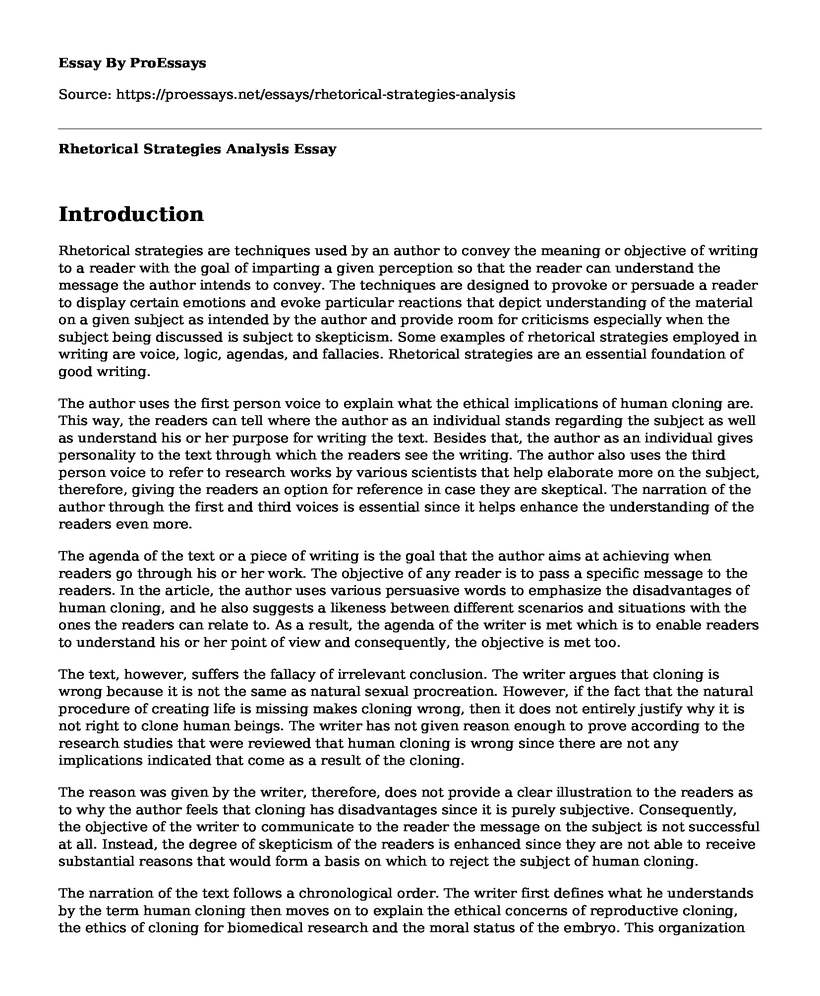Introduction
Rhetorical strategies are techniques used by an author to convey the meaning or objective of writing to a reader with the goal of imparting a given perception so that the reader can understand the message the author intends to convey. The techniques are designed to provoke or persuade a reader to display certain emotions and evoke particular reactions that depict understanding of the material on a given subject as intended by the author and provide room for criticisms especially when the subject being discussed is subject to skepticism. Some examples of rhetorical strategies employed in writing are voice, logic, agendas, and fallacies. Rhetorical strategies are an essential foundation of good writing.
The author uses the first person voice to explain what the ethical implications of human cloning are. This way, the readers can tell where the author as an individual stands regarding the subject as well as understand his or her purpose for writing the text. Besides that, the author as an individual gives personality to the text through which the readers see the writing. The author also uses the third person voice to refer to research works by various scientists that help elaborate more on the subject, therefore, giving the readers an option for reference in case they are skeptical. The narration of the author through the first and third voices is essential since it helps enhance the understanding of the readers even more.
The agenda of the text or a piece of writing is the goal that the author aims at achieving when readers go through his or her work. The objective of any reader is to pass a specific message to the readers. In the article, the author uses various persuasive words to emphasize the disadvantages of human cloning, and he also suggests a likeness between different scenarios and situations with the ones the readers can relate to. As a result, the agenda of the writer is met which is to enable readers to understand his or her point of view and consequently, the objective is met too.
The text, however, suffers the fallacy of irrelevant conclusion. The writer argues that cloning is wrong because it is not the same as natural sexual procreation. However, if the fact that the natural procedure of creating life is missing makes cloning wrong, then it does not entirely justify why it is not right to clone human beings. The writer has not given reason enough to prove according to the research studies that were reviewed that human cloning is wrong since there are not any implications indicated that come as a result of the cloning.
The reason was given by the writer, therefore, does not provide a clear illustration to the readers as to why the author feels that cloning has disadvantages since it is purely subjective. Consequently, the objective of the writer to communicate to the reader the message on the subject is not successful at all. Instead, the degree of skepticism of the readers is enhanced since they are not able to receive substantial reasons that would form a basis on which to reject the subject of human cloning.
The narration of the text follows a chronological order. The writer first defines what he understands by the term human cloning then moves on to explain the ethical concerns of reproductive cloning, the ethics of cloning for biomedical research and the moral status of the embryo. This organization of the text helps the readers to follow up on the significant points that the writer is outlining as well as be able to compare points in different sections and relate them to the points in other parts, therefore, helping them to understand better the message the writer is trying to pass across. The organization of the text in an ordered manner gives logic to the text.
Conclusion
The writer notes, "But suppose that one day, producing a baby through cloning were no riskier than natural reproduction" (Sandel 242) He employs comparison and contrast to ensure the flow of logic throughout the text. The writer compares scenarios whereby cloning is used and where it is not applied to enable the readers to tell the difference between the situations that would allow them to share his views. The readers are therefore able to understand how he came to his conclusions and why the writer takes the stand that human cloning has ethical implications.
Work Cited
Sandel, M.J. (2005). The Ethical Implications of Human Cloning. Perspectives in Biology and Medicine, 48(2), 241-246. Doi:10.1353/pbm.2005.0063
Cite this page
Rhetorical Strategies Analysis. (2022, Apr 16). Retrieved from https://proessays.net/essays/rhetorical-strategies-analysis
If you are the original author of this essay and no longer wish to have it published on the ProEssays website, please click below to request its removal:
- Analysis of the PLOS Blogs Network
- Choreography for Songs Essay
- Movie Analysis Essay on Jim Hubbard's United in Anger
- Alba Madonna by Raphael Essay Example
- The Lincoln Film - Movie Analysis Essay
- Essay Example on Opera, Operetta, and Musicals: 3 Theatrical Forms
- Movie Analysis Essay on The Battle of Algiers







